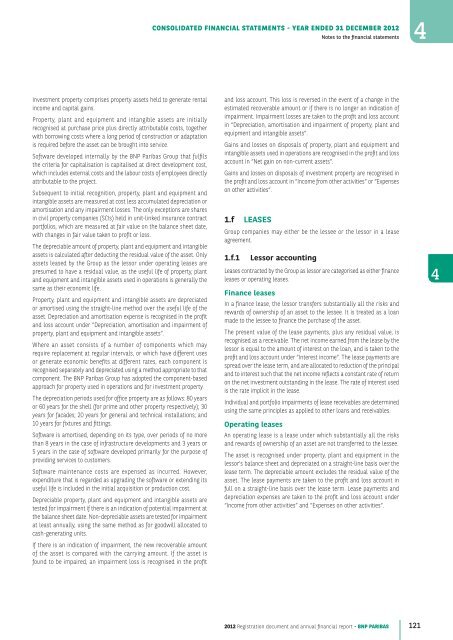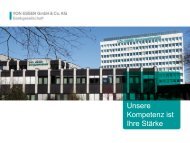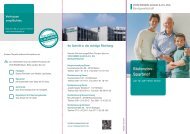2012 Registration document and annual financial report - BNP Paribas
2012 Registration document and annual financial report - BNP Paribas
2012 Registration document and annual financial report - BNP Paribas
- No tags were found...
Create successful ePaper yourself
Turn your PDF publications into a flip-book with our unique Google optimized e-Paper software.
CONSOLIDATED FINANCIAL STATEMENTS - YEAR ENDED 31 DECEMBER <strong>2012</strong>Notes to the <strong>financial</strong> statements4Investment property comprises property assets held to generate rentalincome <strong>and</strong> capital gains.Property, plant <strong>and</strong> equipment <strong>and</strong> intangible assets are initiallyrecognised at purchase price plus directly attributable costs, togetherwith borrowing costs where a long period of construction or adaptationis required before the asset can be brought into service.Software developed internally by the <strong>BNP</strong> <strong>Paribas</strong> Group that fulfilsthe criteria for capitalisation is capitalised at direct development cost,which includes external costs <strong>and</strong> the labour costs of employees directlyattributable to the project.Subsequent to initial recognition, property, plant <strong>and</strong> equipment <strong>and</strong>intangible assets are measured at cost less accumulated depreciation oramortisation <strong>and</strong> any impairment losses. The only exceptions are sharesin civil property companies (SCIs) held in unit-linked insurance contractportfolios, which are measured at fair value on the balance sheet date,with changes in fair value taken to profit or loss.The depreciable amount of property, plant <strong>and</strong> equipment <strong>and</strong> intangibleassets is calculated after deducting the residual value of the asset. Onlyassets leased by the Group as the lessor under operating leases arepresumed to have a residual value, as the useful life of property, plant<strong>and</strong> equipment <strong>and</strong> intangible assets used in operations is generally thesame as their economic life.Property, plant <strong>and</strong> equipment <strong>and</strong> intangible assets are depreciatedor amortised using the straight-line method over the useful life of theasset. Depreciation <strong>and</strong> amortisation expense is recognised in the profit<strong>and</strong> loss account under “Depreciation, amortisation <strong>and</strong> impairment ofproperty, plant <strong>and</strong> equipment <strong>and</strong> intangible assets”.Where an asset consists of a number of components which mayrequire replacement at regular intervals, or which have different usesor generate economic benefits at different rates, each component isrecognised separately <strong>and</strong> depreciated using a method appropriate to thatcomponent. The <strong>BNP</strong> <strong>Paribas</strong> Group has adopted the component-basedapproach for property used in operations <strong>and</strong> for investment property.The depreciation periods used for office property are as follows: 80 yearsor 60 years for the shell (for prime <strong>and</strong> other property respectively); 30years for facades; 20 years for general <strong>and</strong> technical installations; <strong>and</strong>10 years for fixtures <strong>and</strong> fittings.Software is amortised, depending on its type, over periods of no morethan 8 years in the case of infrastructure developments <strong>and</strong> 3 years or5 years in the case of software developed primarily for the purpose ofproviding services to customers.Software maintenance costs are expensed as incurred. However,expenditure that is regarded as upgrading the software or extending itsuseful life is included in the initial acquisition or production cost.Depreciable property, plant <strong>and</strong> equipment <strong>and</strong> intangible assets aretested for impairment if there is an indication of potential impairment atthe balance sheet date. Non-depreciable assets are tested for impairmentat least <strong>annual</strong>ly, using the same method as for goodwill allocated tocash-generating units.If there is an indication of impairment, the new recoverable amountof the asset is compared with the carrying amount. If the asset isfound to be impaired, an impairment loss is recognised in the profit<strong>and</strong> loss account. This loss is reversed in the event of a change in theestimated recoverable amount or if there is no longer an indication ofimpairment. Impairment losses are taken to the profit <strong>and</strong> loss accountin “Depreciation, amortisation <strong>and</strong> impairment of property, plant <strong>and</strong>equipment <strong>and</strong> intangible assets”.Gains <strong>and</strong> losses on disposals of property, plant <strong>and</strong> equipment <strong>and</strong>intangible assets used in operations are recognised in the profit <strong>and</strong> lossaccount in “Net gain on non-current assets”.Gains <strong>and</strong> losses on disposals of investment property are recognised inthe profit <strong>and</strong> loss account in “Income from other activities” or “Expenseson other activities”.1.f LEASESGroup companies may either be the lessee or the lessor in a leaseagreement.1.f.1Lessor accountingLeases contracted by the Group as lessor are categorised as either financeleases or operating leases.Finance leasesIn a finance lease, the lessor transfers substantially all the risks <strong>and</strong>rewards of ownership of an asset to the lessee. It is treated as a loanmade to the lessee to finance the purchase of the asset.The present value of the lease payments, plus any residual value, isrecognised as a receivable. The net income earned from the lease by thelessor is equal to the amount of interest on the loan, <strong>and</strong> is taken to theprofit <strong>and</strong> loss account under “Interest income”. The lease payments arespread over the lease term, <strong>and</strong> are allocated to reduction of the principal<strong>and</strong> to interest such that the net income reflects a constant rate of returnon the net investment outst<strong>and</strong>ing in the lease. The rate of interest usedis the rate implicit in the lease.Individual <strong>and</strong> portfolio impairments of lease receivables are determinedusing the same principles as applied to other loans <strong>and</strong> receivables.Operating leasesAn operating lease is a lease under which substantially all the risks<strong>and</strong> rewards of ownership of an asset are not transferred to the lessee.The asset is recognised under property, plant <strong>and</strong> equipment in thelessor’s balance sheet <strong>and</strong> depreciated on a straight-line basis over thelease term. The depreciable amount excludes the residual value of theasset. The lease payments are taken to the profit <strong>and</strong> loss account infull on a straight-line basis over the lease term. Lease payments <strong>and</strong>depreciation expenses are taken to the profit <strong>and</strong> loss account under“Income from other activities” <strong>and</strong> “Expenses on other activities”.4<strong>2012</strong> <strong>Registration</strong> <strong>document</strong> <strong>and</strong> <strong>annual</strong> <strong>financial</strong> <strong>report</strong> - <strong>BNP</strong> PARIBAS 121





